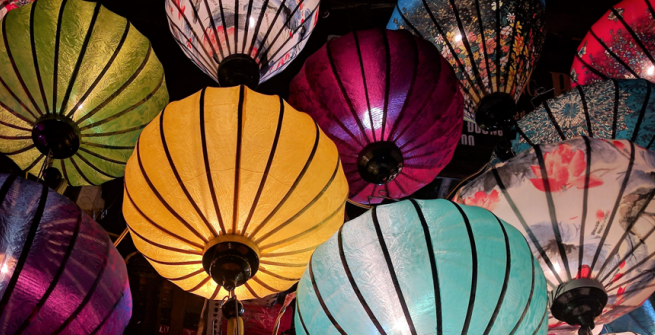Did you know that the New Year celebrations are among the oldest and most universally observed festivities in world cultures. At the heart of the celebrations is the remembrance of creation and life’s renewal. The observation for the New Year for many Asian cultures follow the Lunisolar calendar, however, there are some Asian cultures that celebrate the New Year according to the Gregorian Calendar.
In China, the new year is ushered through Chūn Jié, (the Spring Festival). The legend has it that the Chinese new year started with a fight against a mythical lion and bull-like creature. When the villagers learned that the creature feared fire, loud noises, and the color red, they covered their houses in red and even lit firecrackers to scare him off. In our days, people honor the legend by hanging red lanterns as well as dancing through the streets as lions and dragons.
In Japan, the celebration of the new year starts on New Year’s Eve (Omisoka). As soon as people hear temple bells sound 108 times (Joya no kane), they rush to temples and shrines to pray for a happy and healthy year (Hatsumōde). The first three days of the year (Sanganichi) is called Oshōgatsu. Special meals called Osechi Ryori are enjoyed during Oshōgatsu. One of the traditional games enjoyed is Fukuwarai (lucky laugh) which is played by kindly directing blindfolded players to place paper cutouts of a face, such as a mouth, a nose, cheeks, eyebrows, and eyes on a paper face.
In Korea, the new year celebration is generally referred to as Seollal, which usually lasts for three days - the day of, the day before, and the day after. Traditionally, the morning of Seollal begins when the family members gather together in their seolbim, an item of special clothing for Seollal, for an ancestral rite. The purpose of the rite is to express respect and gratitude to the ancestors. After the rite, people gather together and eat a traditional soup, called tteokguk. In Korea, the clear broth of tteokguk symbolizes starting of the new year with a pure mind and body.범아시아 새해맞이 축하행사
여러분 사실을 아십니까? 이 축하행사는 창조를 되새기며 생명의 새로운 시작을 의미합니다. 한국과 중국 등 아시아의 많은 나라는 새해를 음력으로 지키는 한편, 일본을 비롯한 몇 나라들은 양력(그레고리안 달력)을 따라 지킵니다.
중국에서의 새해는 봄 축제인 춘제(春節)로 이어집니다. 전설에 의하면 중국의 설날은 신화 속에 등장하는 사자와 황소같이 생긴 동물과의 싸움으로 시작되었다고 합니다. 마을 사람들은 이 동물이 불과 시끄러운 소리 그리고 빨간색을 두려워한다는 것을 알고 그들의 집을 빨간색으로 칠하고 겁을 주기 위해 폭죽을 터트렸습니다. 현대 사람들은 빨간 등불을 매달고 사자와 용의 탈을 쓰고 거리에서 춤을 추며 이 전설을 기념합니다.
일본의 새해 축하는 한 해의 마지막 날 저녁(오미소카)부터 시작됩니다. 사람들이 절에서 108번의 종소리(조야 노 카네)가 들리면 절 또는 신사로 달려가 행복하고 건강한 한 해(하츠모데)를 기원합니다. 오쇼가츠라고 불리는 일본의 설날은 1월의 첫 3일(상가니치) 동안 지키는데 이 기간에 오세치 료리라는 특별한 음식을 먹습니다. 또한, 사람들이 즐기는 전통놀이 중 하나는 후쿠와라이(행운의 웃음)라고 불리는데, 눈가리개를 한 사람이 오려낸 종이 입, 코, 볼, 눈썹, 눈 등을 종이 얼굴에 붙이는 것입니다.
한국 새해는 설날이라 불립니다. 보통 새해 당일과 앞뒤 하루를 포함해 3일간 연휴로 지킵니다. 전통적으로 설날은 아침에 설빔(설날에 입는 새 옷)을 입은 가족들이 함께 모여 차례를 지내면서 시작됩니다. 이 차례의식은 조상들에게 존경과 감사를 표하는 것입니다. 차례가 끝나면 식구, 친척들이 함께 떡국을 먹는데 이 떡국의 맑은 국물은 순수한 마음과 몸으로 새해를 시작하는 것을 의미합니다.
로스앤젤레스 시립도서관은 오는 1월 23일(토요일) 오후 1시에 페이스북과 유튜브를 통해 온 가족이 참여하고 즐기고 배울 수 있는 프로그램인 ‘범아시아 새해맞이 축하행사’에 여러분을 초대합니다. 이 프로그램은 중국 서예에 관한 강좌와 시범, 중국 전통음악, 일본의 새해 전통요리 소개와 게임, 한국의 음악, 무용, 한복의 역사, 전통음식과 어린이를 위한 스토리타임 등으로 다채롭게 진행됩니다. 이 특별한 행사에 많은 참여를 기대합니다.
